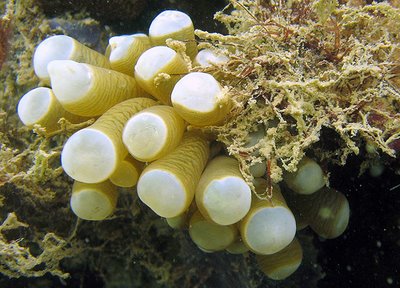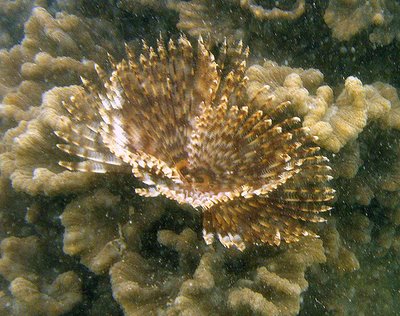Blog Log, 29 July 2007
 July 31, 2007
July 31, 2007
The cold and wet weather throughout the week made me a bit nervous about going for a dive. The last we hope for is having to cancel a dive because of bad and dangerous weather. But we should be so lucky, as moderate to good weather held up on Sunday, and thank goodness! Because Keppel Marina is undergoing renovations through to next year, we departed from Pasir Panjang Ferry Terminal.
 Though we saw generally fewer nudibranches than were were used to on the reef, there were some super finds that made the trip all worth our while. Silver moonies and schools of damsels played the top of the reef slope, and in the deep I encountered my first Ceratosoma Trilobatum Nudibranch. Thanks to Chay Hoon for spotting it for me! Thanks also to her for taking all the lovely pictures featured in this Blog Log as I so cleverly brought my camera less the memory card this trip!
Though we saw generally fewer nudibranches than were were used to on the reef, there were some super finds that made the trip all worth our while. Silver moonies and schools of damsels played the top of the reef slope, and in the deep I encountered my first Ceratosoma Trilobatum Nudibranch. Thanks to Chay Hoon for spotting it for me! Thanks also to her for taking all the lovely pictures featured in this Blog Log as I so cleverly brought my camera less the memory card this trip!
 We did manage to spot some Blue Dragon nudibranches such as the one above, which was really tiny! Other tiny creatures that we manage to spot were cuttlefish! Chay Hoon and I spotted 3 altogether, and in 3 different sizes too! One was the size of your pinky nail, the 2nd the size of date, and the last one was about the size of a clenched fist.
We did manage to spot some Blue Dragon nudibranches such as the one above, which was really tiny! Other tiny creatures that we manage to spot were cuttlefish! Chay Hoon and I spotted 3 altogether, and in 3 different sizes too! One was the size of your pinky nail, the 2nd the size of date, and the last one was about the size of a clenched fist.
 Another beautiful nudibranch we ran into was this Chromodoris Lineolata. Chay Hoon and her amazing memory, blurted the its Latin name the moment we surfaced from the dive! I was flabberghasted. These critters feed on sponges and are found throughout the tropical Indo-West Pacific, growing up to 30cm!
Another beautiful nudibranch we ran into was this Chromodoris Lineolata. Chay Hoon and her amazing memory, blurted the its Latin name the moment we surfaced from the dive! I was flabberghasted. These critters feed on sponges and are found throughout the tropical Indo-West Pacific, growing up to 30cm!
 Take a closer look at this photo of the Icon Seastar, and you’ll notice quite unusual. There’s a tiny mollusc called Thyca crystallina right in the middle, on top of the seastar. It’s a parasitic sea snail that lives and feeds usually on the underside of seastars, most commonly found in shallow reef-top locations.
Take a closer look at this photo of the Icon Seastar, and you’ll notice quite unusual. There’s a tiny mollusc called Thyca crystallina right in the middle, on top of the seastar. It’s a parasitic sea snail that lives and feeds usually on the underside of seastars, most commonly found in shallow reef-top locations.
 Zoanthids are commonly sought after in the aquarium trade. In an aquarium, zoanthids are a demanding species of coral and require great effort to maintain. On the reef, zoanthids are sought after as prey by Hawksbill turtles.
Zoanthids are commonly sought after in the aquarium trade. In an aquarium, zoanthids are a demanding species of coral and require great effort to maintain. On the reef, zoanthids are sought after as prey by Hawksbill turtles.
 Acoel Flatworms are often mistaken for nudibranches. Some species of acoel tend to be small predators of copepods, other small flatworms. They are not parasitic, but can reportedly damage corals by shading. Similar to corals, some species of acoel incorporate zooxanthellae in their bodies. Given enough food and enough light, they multiplies asexually. Normally, however, the worms disappear on their own accord after a few months, presumably after having exhausted some necessary nutrient. Mandarin fish purportedly feed on acoel flatworms.
Acoel Flatworms are often mistaken for nudibranches. Some species of acoel tend to be small predators of copepods, other small flatworms. They are not parasitic, but can reportedly damage corals by shading. Similar to corals, some species of acoel incorporate zooxanthellae in their bodies. Given enough food and enough light, they multiplies asexually. Normally, however, the worms disappear on their own accord after a few months, presumably after having exhausted some necessary nutrient. Mandarin fish purportedly feed on acoel flatworms.
 A mushroom coral recruit amongst the algae, with its tentacles outreached.
A mushroom coral recruit amongst the algae, with its tentacles outreached.
 A juvenile Harlequin Sweetlips frolicks amongst Goniopora coral.
A juvenile Harlequin Sweetlips frolicks amongst Goniopora coral.
 Found worldwide in tropical and sup-tropical seas, primarily in sandy or muddy bottoms, tube anemones are another species that are highly sought after in the aquarium trade. Tube anemones are characteristically slender smooth cones topped with two sets of dissimilar tentacles. The outer fringing tentacles are particularly well armed with stinging cells. The shorter (less than two inch) inner labial or oral tentacles assist in food gathering and manipulation.
Found worldwide in tropical and sup-tropical seas, primarily in sandy or muddy bottoms, tube anemones are another species that are highly sought after in the aquarium trade. Tube anemones are characteristically slender smooth cones topped with two sets of dissimilar tentacles. The outer fringing tentacles are particularly well armed with stinging cells. The shorter (less than two inch) inner labial or oral tentacles assist in food gathering and manipulation.
 A large marine flatworm, and possibly one of the most commonly encountered species on our reefs. Pseudobiceros sp.
A large marine flatworm, and possibly one of the most commonly encountered species on our reefs. Pseudobiceros sp.
 Tomato clown anemonefish are usually found together with bubbletip anemones, as I was told by Chay Hoon. These fish feed on zooplankton and algage amongst other things. They have also been observed to take care of the anemone they are living in by feeding it! As they say: There ain’t so such thing as a free lunch!
Tomato clown anemonefish are usually found together with bubbletip anemones, as I was told by Chay Hoon. These fish feed on zooplankton and algage amongst other things. They have also been observed to take care of the anemone they are living in by feeding it! As they say: There ain’t so such thing as a free lunch!
 A tube worm with its feeding tentacles outstretched. That summed up the end of our day. Other critters we saw but didn’t manage to photograph include: juvenile Tiera batfish, Six-banded angelfish, Emperor
A tube worm with its feeding tentacles outstretched. That summed up the end of our day. Other critters we saw but didn’t manage to photograph include: juvenile Tiera batfish, Six-banded angelfish, Emperor
grouper, Eight-banded butterflyfish, Long-beaked butterflyfish, Paradise whiptail, Dotted Sweetlips.
For more photos of Hantu’s marine life, and a host of other beautiful living creatures in Singapore’s shores and waters, check out Chay Hoon’s Flickr site and be BLOWN AWAY!
 Posted in
Posted in 



 content rss
content rss
COMMENTS